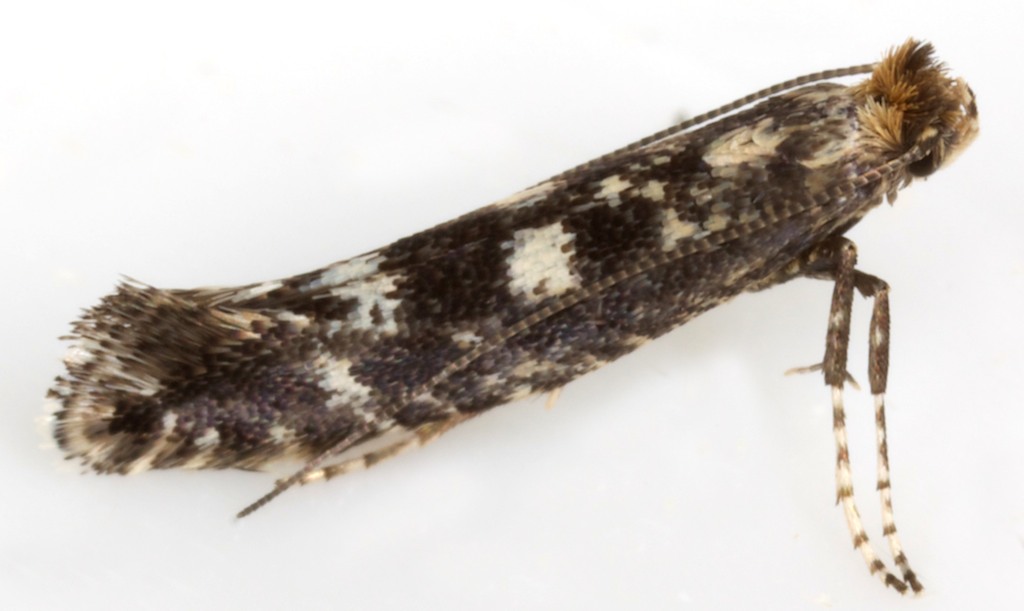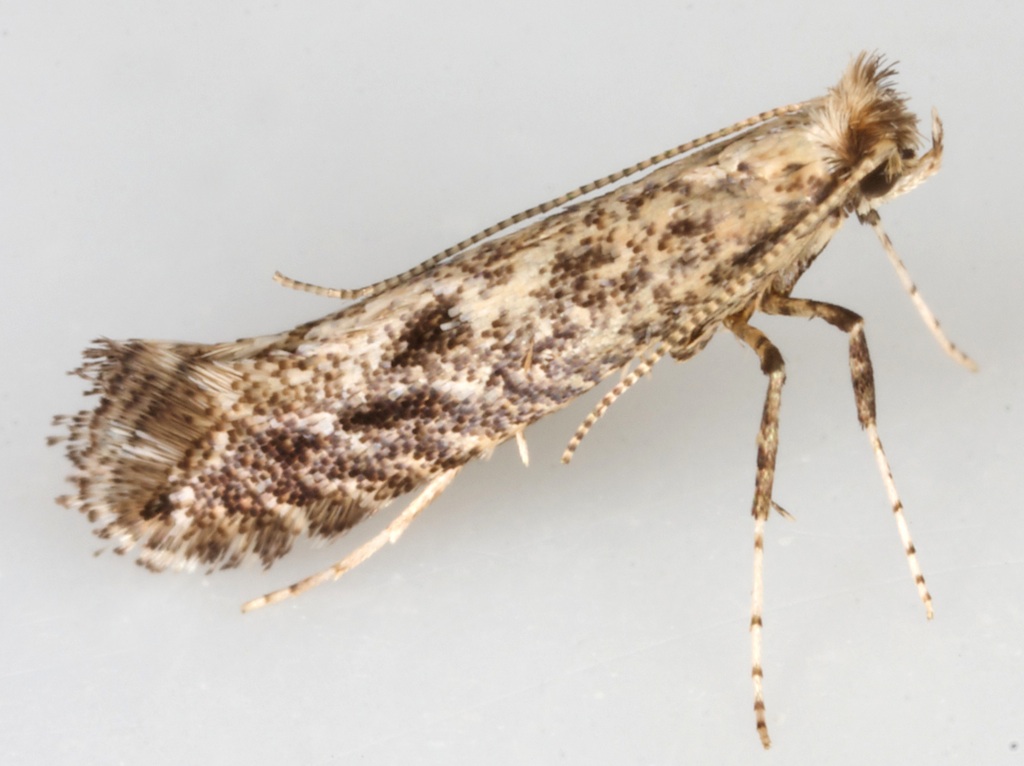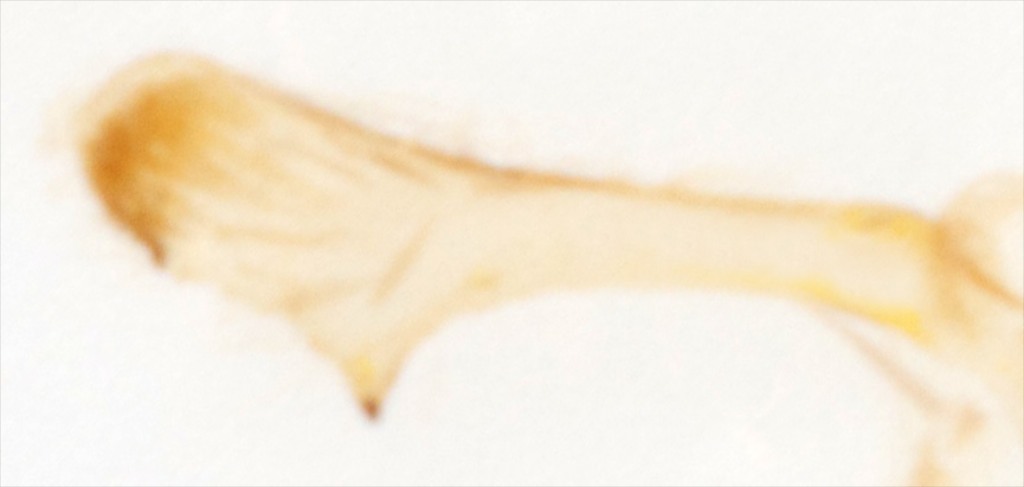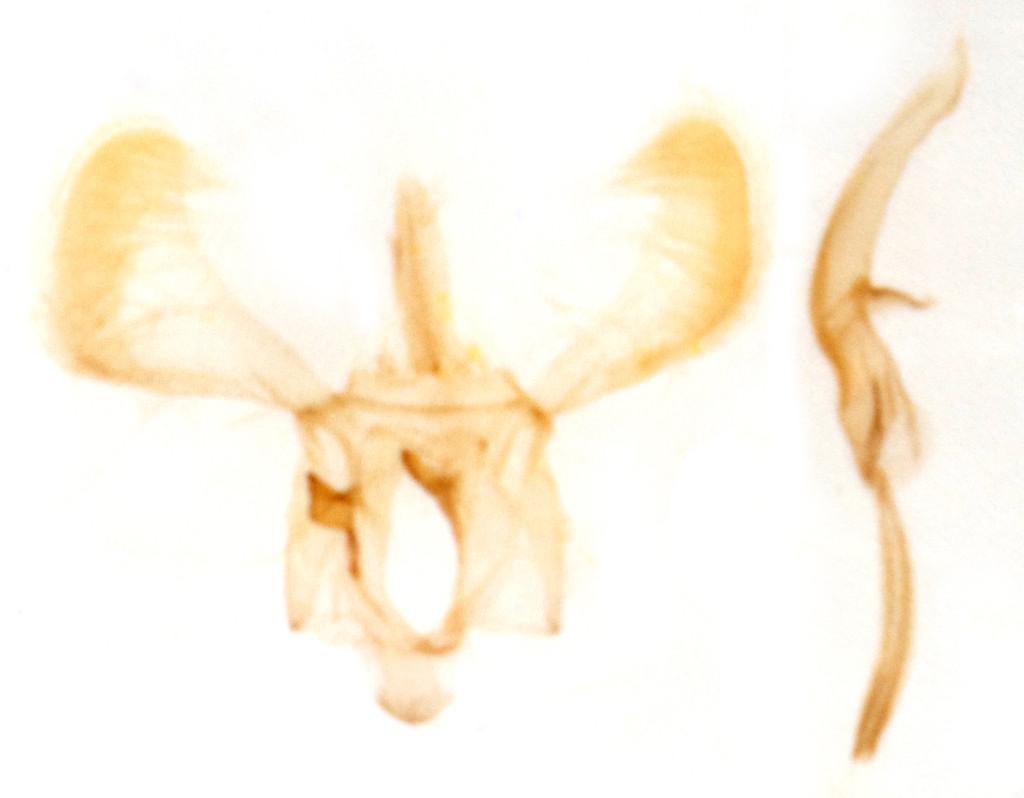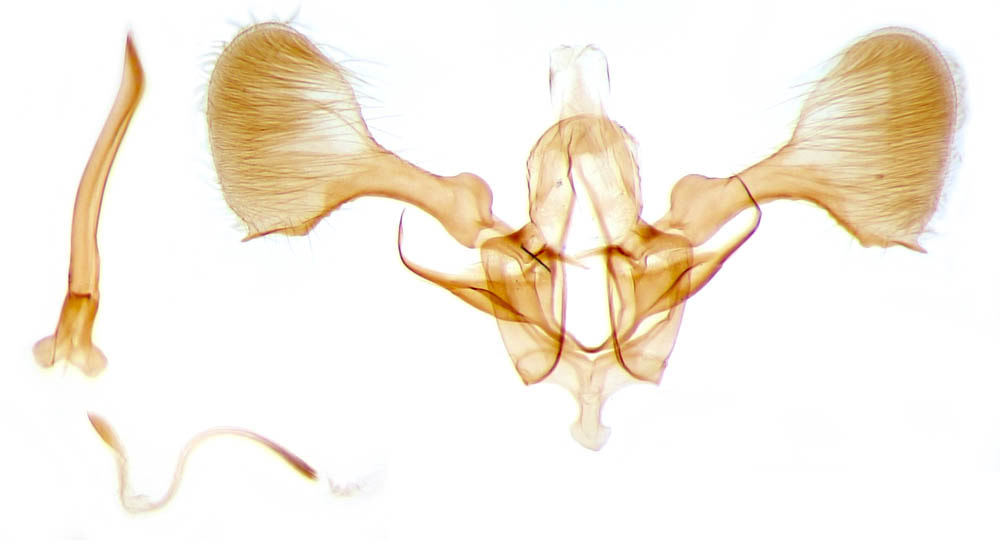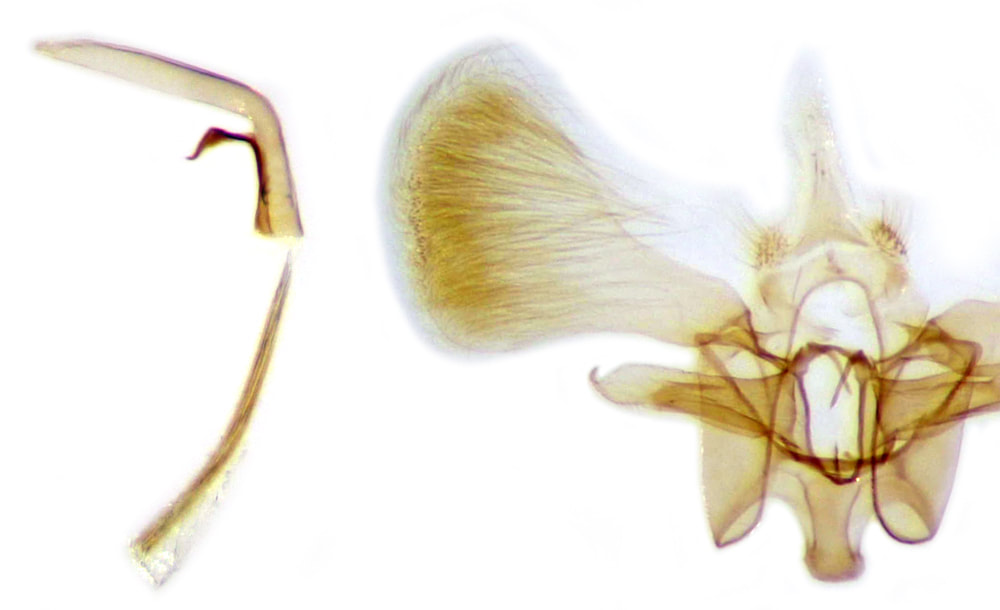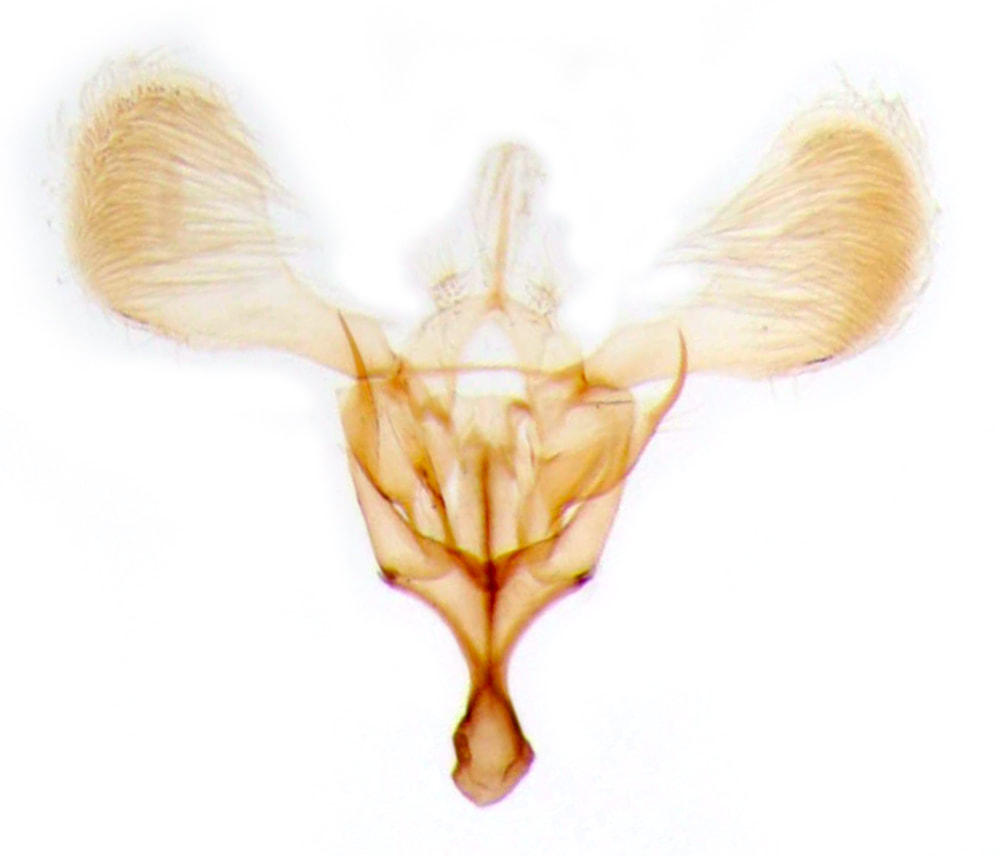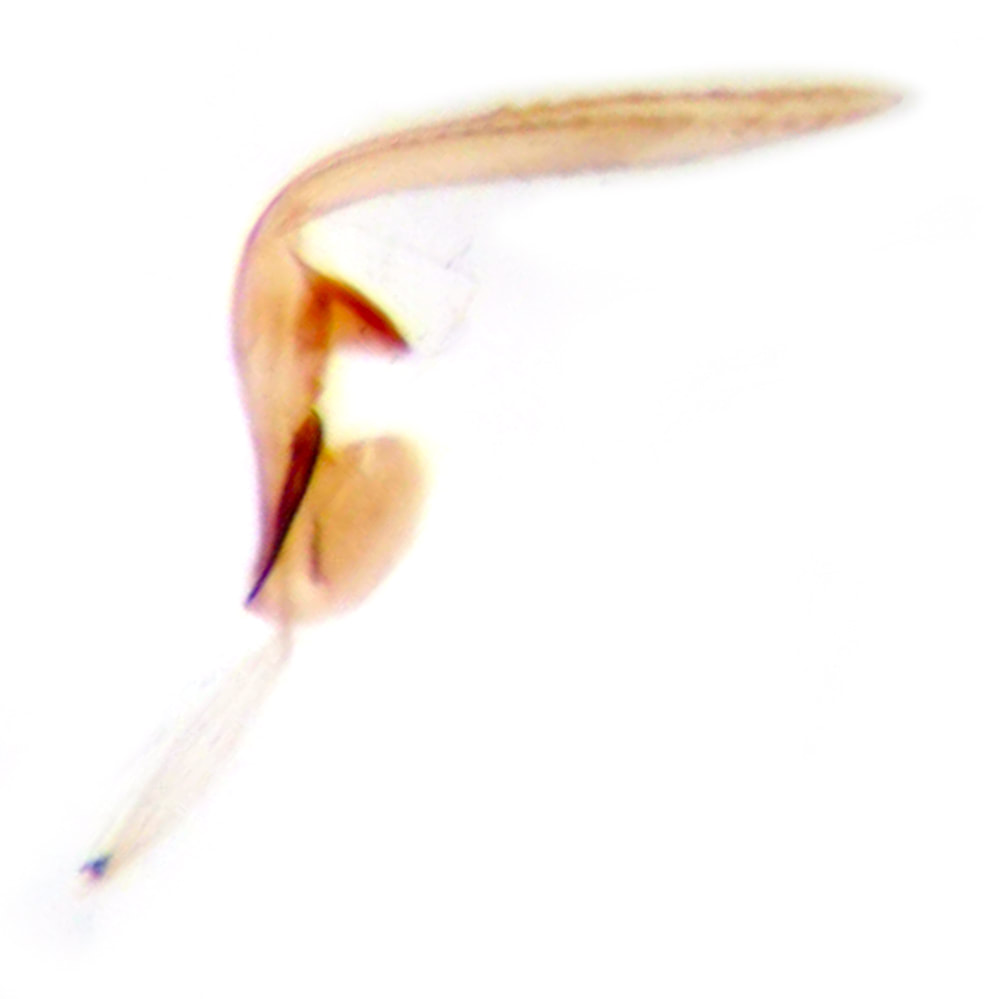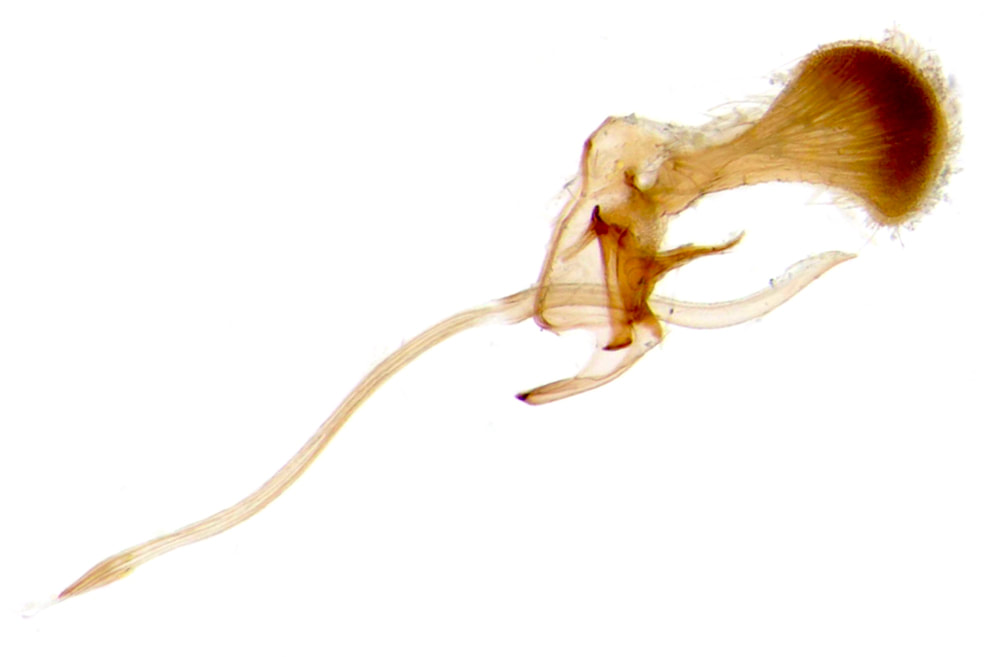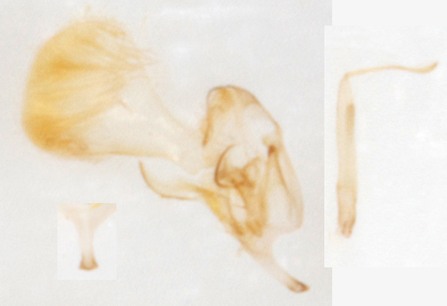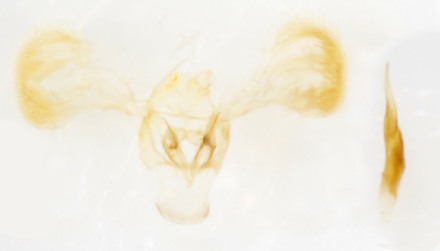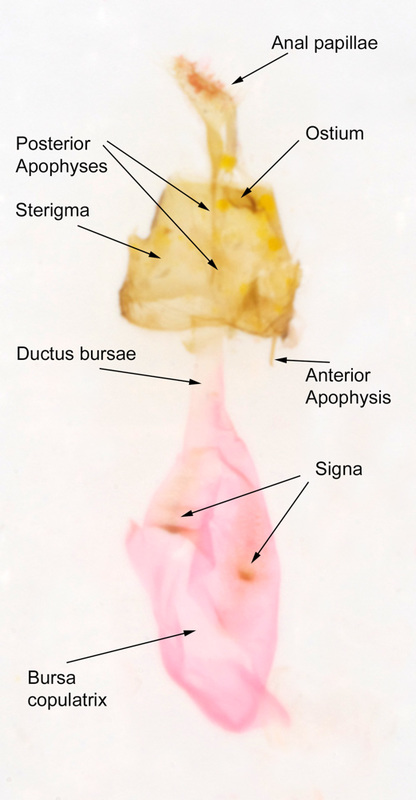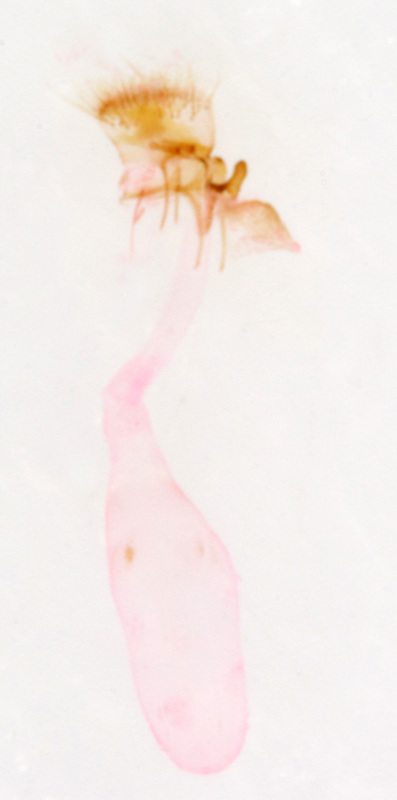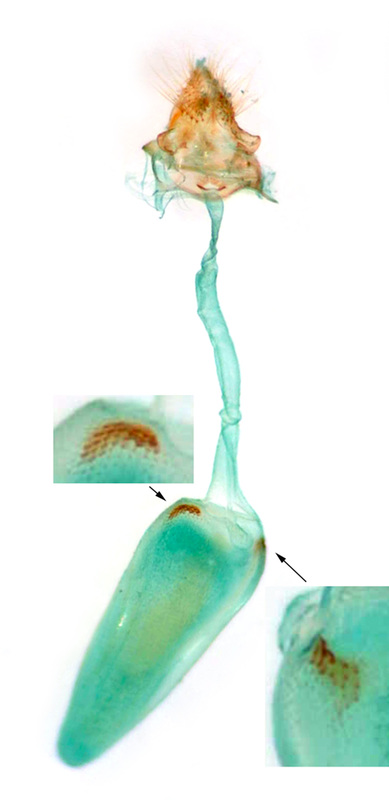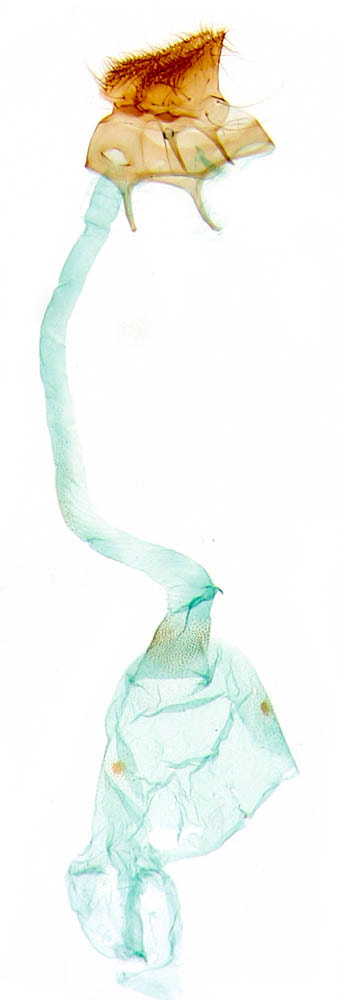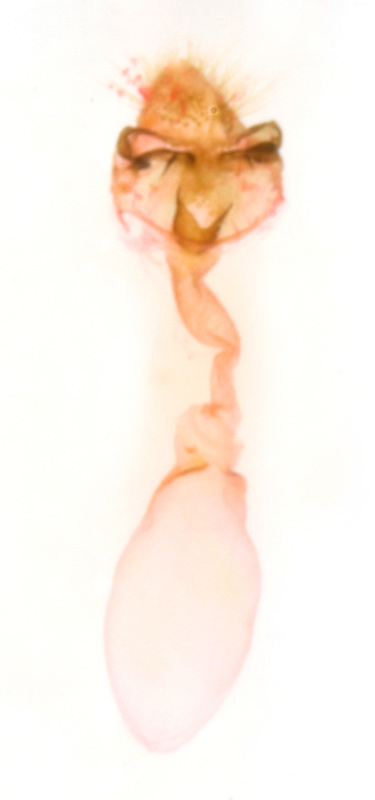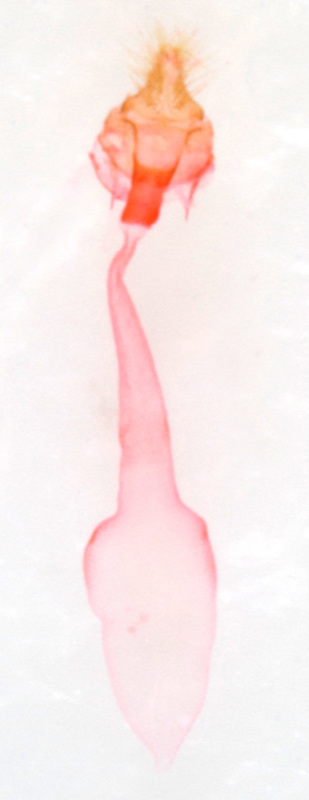Parornix |
Distinct from all other Gracillariidae by the combination of rough-haired head, hindtibia without bristles, midtibia thickened with projecting scales and scape with a pecten. Less distinctly marked than most Gracillariids and the 10 British species are very similar to each other.
P.betulae/anglicella/devoniella/scoticella/torquilella can be found throughout GB. P.loganella is found in Scotland and N.England; P.fagivora is mostly confined to S.England; P.finitimella is found in South and Central England and South Wales; P.alpicola is very local on the North coast of Scotland and P.carpinella is not listed in MBGBI2 but occurs in SE.England.
Most are bivoltine flying May and August; P.torquilella flies May-Jul and Scottish populations are usually univoltine May-Jun.
P.betulae/anglicella/devoniella/scoticella/torquilella can be found throughout GB. P.loganella is found in Scotland and N.England; P.fagivora is mostly confined to S.England; P.finitimella is found in South and Central England and South Wales; P.alpicola is very local on the North coast of Scotland and P.carpinella is not listed in MBGBI2 but occurs in SE.England.
Most are bivoltine flying May and August; P.torquilella flies May-Jul and Scottish populations are usually univoltine May-Jun.
|
P.loganella (left) has a dark blackish-fuscous forewing with strongly contrasting dorsal white markings. It is the only Parornix species that can be confidently identified on external features. Other species are greyish-fuscous or brownish-fuscous mixed whitish with a series of whitish costal strigulae - as in the image on the right (P.devoniella).
|
Male genitalia
P.betulae/anglicella/devoniella/scoticella/finitimella/torquilella are illustrated in MBGBI2 pp281 & 287.
All except P.alpicola are shown at Dissection Group. P.alpicola will not be considered further for the time being.
P.betulae/anglicella/devoniella/scoticella/finitimella/torquilella are illustrated in MBGBI2 pp281 & 287.
All except P.alpicola are shown at Dissection Group. P.alpicola will not be considered further for the time being.
|
The male genitalia of P.torquillella are distinct from other Parornix species in having a more elongate valva gradually expanding in width from base to apex and with a distinct spine at the junction of the ventral and lateral margins. In other Parornix species the valva has a narrow base and then a rapid expansion into a rounded apex and no costal spine (except that a small one is present in P.finitimella). P.torquilella also lacks the anellus lobes seen in all other species and its aedeagus has a strong paramere, not seen in any other species.
All these differences fully justify its placement in a separate genus (Deltaornix) and cast considerable doubt on the validity of amalgamating it with Parornix (in my opinion) |
The 7 remaining Parornix species can be separated on 4 features:
1. Presence of a sclerotised portion of vesica (ductus ejaculatorius) extending basally from the aedeagus in P.loganella/anglicella/scoticella/finitimella/carpinella; this portion of vesica being uncsclerotised in P.betulae/devoniella/fagivora. In P.scoticella/carpinella the sclerotised portion of vesica is longer than the aedeagal sheath, much longer in the case of P.scoticella and slightly longer in P.carpinella; while in P.anglicella it is slightly shorter, in P.loganella much shorter and in P.finitimella it is much shorter and distant from the tunica.
2. Shape of saccus. Longer than wide and blob-ended in P.betulae/devoniella. Narrow with a blob -end at the tip in P.betulae. Broader with a blob-end occupying about 1/2 the length of the saccus in P.devoniella. About as wide as long and truncate to rounded in P.anglicella/scoticella/finitimella/carpinella/fagivora. (Clearly broader than long in P.loganella)
3. Shape of valva. Lateral margin fairly evenly rounded in all except P.anglicella which is straighter in its ventral 2/3 and with a more angular junction of ventral and lateral margins; and P.finitimella which has a small spur at junction of ventral and lateral margins.
4. Length and shape of the juxta lobes (I think that is what they are). Described in association with the images below.
1. Presence of a sclerotised portion of vesica (ductus ejaculatorius) extending basally from the aedeagus in P.loganella/anglicella/scoticella/finitimella/carpinella; this portion of vesica being uncsclerotised in P.betulae/devoniella/fagivora. In P.scoticella/carpinella the sclerotised portion of vesica is longer than the aedeagal sheath, much longer in the case of P.scoticella and slightly longer in P.carpinella; while in P.anglicella it is slightly shorter, in P.loganella much shorter and in P.finitimella it is much shorter and distant from the tunica.
2. Shape of saccus. Longer than wide and blob-ended in P.betulae/devoniella. Narrow with a blob -end at the tip in P.betulae. Broader with a blob-end occupying about 1/2 the length of the saccus in P.devoniella. About as wide as long and truncate to rounded in P.anglicella/scoticella/finitimella/carpinella/fagivora. (Clearly broader than long in P.loganella)
3. Shape of valva. Lateral margin fairly evenly rounded in all except P.anglicella which is straighter in its ventral 2/3 and with a more angular junction of ventral and lateral margins; and P.finitimella which has a small spur at junction of ventral and lateral margins.
4. Length and shape of the juxta lobes (I think that is what they are). Described in association with the images below.
|
P.anglicella (below)
1. Sclerotised portion of vesica shorter than the aedeagal sheath. 2. Saccus about as wide as long 3. Valva: a rounded right angle at junction of ventral and lateral margins, the ventral 2/3 of the lateral margin fairly straight and forms an angle with the dorsal 1/3 which is rounded 4. Juxta lobes short |
P.finitimella (below)
1. Sclerotised portion of vesica - about as long as aedeagal sheath 2. Saccus about as wide as long 3. Valva: a small projection at the junction of the ventral and lateral margins. 4. Juxta lobes very long and tapering |
|
P.carpinella (below)
1. Sclerotised portion of vesica slightly longer than the aedeagal sheath 2. Saccus about as wide as long 3. Valva: lateral margin fairly evenly rounded 4. Juxta lobes long with an abrupt narrowing to a point at the apex P.devoniella (below)
Has a midline linear projection from posterior margin of saccus Apex of aedeagus finely dentate Base of aedeagus with an expanded plate 1. No sclerotised portion of vesica beyond the aedeagal sheath (but there is a short unsclerotised moderately robust portion of vesica) 2. Saccus longer than wide with a substantial blob-end 3. Valva: lateral margin fairly evenly rounded 4. Juxta lobes medium length, globular in basal half then abruptly narrow in apical 1/2 |
P.scoticella (below)
1. Sclerotised portion of vesica much longer than the aedeagal sheath 2. Saccus about as wide as long 3. Valva: lateral margin fairly evenly rounded 4. Juxta lobes medium length and narrow beyond the basal 1/3 P.betulae (below)
1. Weakly sclerotised portion of vesica beyond the aedeagal sheath; variable filamentous apex 2. Saccus longer than wide with a small blob-end 3. Valva: lateral margin fairly evenly rounded 4. Juxta lobes medium length, gradually tapering to apex P.fagivora (no material)
1. No sclerotised portion of vesica beyond the aedeagal sheath 2. Saccus slightly broader than long 3. Valva: lateral margin fairly evenly rounded 4. Juxta lobes medium length, broad for most of length then narrowing to a point in the apical 1/4 P.loganella (below)
1. No sclerotised portion of vesica beyond the aedeagal sheath 2. Saccus clearly broader than long 3. Valva: lateral margin fairly evenly rounded 4. Juxta lobes medium length (with a right angle bend at 1/2?) |
Female genitalia
P.betulae/anglicella/devoniella/scoticella/finitimella/torquilella are illustrated in MBGBI2 pp281 & 287.
All except P.carpinella and P.alpicola are shown at Dissection Group. P.alpicola will not be considered further for the time being.
Images of P.carpinella are available at Lepiforum.de
Descriptions here are based on comparison of these illustrations and images.
The species are separable on the following features of the female genitalia:
1. Sclerotisation of the sterigma, ostium and introitus vaginae (IV)
2. Relative length of the ductus bursae (DB) and bursa copulatrix (BC) *
3. Shape of the ductus bursae
(4. Form of the signa?)
* This can be difficult to assess from images at Dissection Group as the bursa has been collapsed in some of them.
P.betulae/anglicella/devoniella/scoticella/finitimella/torquilella are illustrated in MBGBI2 pp281 & 287.
All except P.carpinella and P.alpicola are shown at Dissection Group. P.alpicola will not be considered further for the time being.
Images of P.carpinella are available at Lepiforum.de
Descriptions here are based on comparison of these illustrations and images.
The species are separable on the following features of the female genitalia:
1. Sclerotisation of the sterigma, ostium and introitus vaginae (IV)
2. Relative length of the ductus bursae (DB) and bursa copulatrix (BC) *
3. Shape of the ductus bursae
(4. Form of the signa?)
* This can be difficult to assess from images at Dissection Group as the bursa has been collapsed in some of them.
|
P.devoniella (below)
1.The sterigma has a strongly sclerotised triangular plate broadest at the anterior margin, forming the ventral surface of the ostium (shown here in lateral view. The apophyses anteriores are also distinctly longer than in any other Parornix species. 2. Ductus bursae shorter than bursa copulatrix in the image below, but is drawn about the same length as the bursa in MBGBI2. 3. Ductus bursae of even width in posterior 2/3 then expands to junction with bursa. 4. 2 small smudgy signa with little surrounding spiculation. P.betulae (below)
1. Sterigma and ostium weakly sclerotised; ostium small; near anterior margin; no identifiable IV. 2. DB about same length as CB. 3, DB narrow throughout its length, broadening abruptly at junction with BC 4. 2 fairly distinct, somewhat linear, spiculate signa, with a little surrounding spiculation. P.scoticella
1. ostium a narrow slit near anterior margin of A8; no distinct antrum 2. DB ~1.5x length of CB 3. DB spiculation at junction with corpus 4. 2 distinct round signa with surrounding spiculation. P.finitimella (no material)
1. Sterigma and ostium poorly sclerotised; ostium small, round, at anterior margin of sterigma; no identifiable IV. 2. DB almost 2x length of BC 3. DB very narrow throughout its length 4. 2 round signa with surrounding spiculation. |
P. torquillella (left)
1. Sterigma poorly sclerotised; ostium near posterior margin with minimal periostial sclerotisation. 2. Ductus bursae ~1/2 as long as bursa copulatrix. 3. Short, of fairly even diameter posteriorly then expanding into bursa copulatrix. 4. 2 smudgy round signa with some surrounding spiculation P.loganella (below) 1. Sterigma with a well-sclerotised posterior margin; ostium towards anterior margin; introitus vaginae strongly sclerotised with a 'V'-shaped posterior margin (which is the anterior margin of the ostium) 2. Ductus bursae slightly shorter than bursa copulatrix. 3. Ductus bursae as broad as introitus vaginae and spiculate in posterior 2/3, then kinked and narrowed in anterior 1/3; junction with bursa copulatrix fairly abrupt. 4. 2 spiculate linear signa. P.fagivora (below)
1. Ostium large, incised from the posterior margin of the sterigma and occupying most of the length of the sterigma; strongly sclerotised lateral margins of the ostium; strong sclerotisation of introitus vaginae about 2x as long as broad. 2. DB slightly longer than CB. 3. DB narrows abruptly anterior to IV, kinks and then gradually expands to junction with CB; DB spiculate for much of its length. 4. 2 round smudgy signa with some surrounding spiculation. P.carpinella (no material)
Description based on images at Lepiforum.de 1. Ostium a broad, weakly sclerotised slit near centre of sterigma; IV not sclerotised or spiculate. 2. DB slightly longer than CB? 3. DB same width as IV, and heavily spiculate, in posterior portion (for about same length as ovipositor) then kinks slightly and gradually expands into CB with no clear junction. less densely spiculate in anterior portion. 4. 2 round smudgy signa with some surrounding spiculation. P.anglicella (below)
1. Sterigma poorly sclerotised; ostium near anterior margin of sterigma, poorly sclerotised apart from a small 'U'-shaped plate, slightly wider than long, and a notched posterior margin. 2. DB ~1.5x length of BC 3. DB narrows a little for a short section anterior to IV, then broadens and is of fairly even width for most of its length then broadening gradually to junction with BC. Spiculate sections just anterior to the narrowing and near junction with BC. 4. 2 rounded spiculate signa with some surrounding spiculation. |
Updated 23/05/2016 to reidentify the female image of P.carpinella as P.fagivora and amend text accordingly | Text amended 27/01/2020 |
Text amended 04/08/2021
Text amended 04/08/2021
